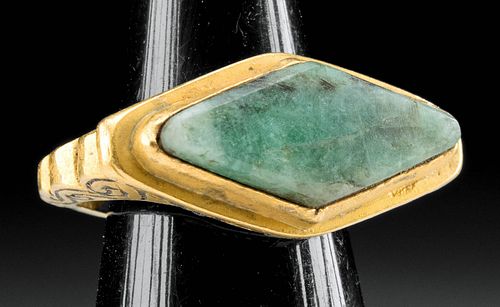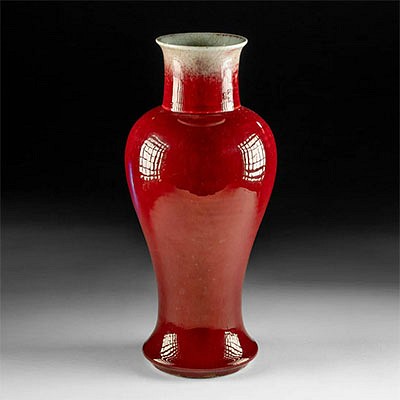6th C. Byzantine Gold Ring Beryl Stone
Lot 101
About Seller
Artemis Gallery
686 S Taylor Ave, Ste 106
Louisville, CO 80027
United States
Selling antiquities, ancient and ethnographic art online since 1993, Artemis Gallery specializes in Classical Antiquities (Egyptian, Greek, Roman, Near Eastern), Asian, Pre-Columbian, African / Tribal / Oceanographic art. Our extensive inventory includes pottery, stone, metal, wood, glass and textil...Read more
Estimate:
$6,000 - $9,000
Absentee vs Live bid
Two ways to bid:
- Leave a max absentee bid and the platform will bid on your behalf up to your maximum bid during the live auction.
- Bid live during the auction and your bids will be submitted real-time to the auctioneer.
Bid Increments
| Price | Bid Increment |
|---|---|
| $0 | $25 |
| $300 | $50 |
| $1,000 | $100 |
| $2,000 | $250 |
| $5,000 | $500 |
| $10,000 | $1,000 |
| $20,000 | $2,500 |
| $50,000 | $5,000 |
| $100,000 | $10,000 |
| $200,000 | $20,000 |
About Auction
By Artemis Gallery
May 11, 2023
Set Reminder
2023-05-11 10:00:00
2023-05-11 10:00:00
America/New_York
Bidsquare
Bidsquare : Fine Antiquities, Asian, Pre-Columbian, Ethnographic Art
https://www.bidsquare.com/auctions/artemis-gallery/fine-antiquities-asian-pre-columbian-ethnographic-art-12771
Classical antiquities, ancient and ethnographic art from cultures encompassing the globe. Artemis Gallery info@artemisgallery.com
Classical antiquities, ancient and ethnographic art from cultures encompassing the globe. Artemis Gallery info@artemisgallery.com
- Lot Description
**Originally Listed At $4250**
Near East, Byzantine Period, ca. 6th to 7th century CE. A gorgeous high-quality gold ring inlaid with a sizable beryl stone cut into a rhomboid shape. The 84.9% to 92.03% gold (equivalent to 20K+ to 22K+) shank widens at the shoulders, the peripheries of this area are scalloped and decorated with dark niello swirls in scrolling motifs. The lozenge face is accented with niello stippling around the lower edge of both sides, while the form fitting lip is smooth, firmly securing the polished beryl which displays lovely opaque mint and seafoam green hues. This exceptional piece is in a near perfect state of preservation and wearable - finely modelled and created by a skilled artisan to last long after the original wearer's life. Due to the ovoid shape of the band, the ring is not accurately measurable on ring sizer mandrel but is likely a US 9.5 to 10 ring size. Size of ring face: 1.14" L x 0.53" W (2.9 cm x 1.3 cm); band opening: 0.95" Diameter (2.4 cm); US ring size 9.5; gold quality: 84.9% to 92.03% (equivalent to 20K+ to 22K+); weight: 14.6 grams
Rings were of particularly high importance in the Byzantine era, as evidenced by this incredible example, and they generally were modeled after Roman styles using similar techniques, and Byzantine jewelry in turn influenced the Medieval world. Status has always been conveyed using jewelry, however the wealth and prosperity of the Byzantine Empire ensured the widespread ownership of finer jewelry - so much so, that when Emperor Justinian enacted the set of laws known as the Justinian Code, there was a specific decree that restricted certain precious stones to exclusively royal use, while every free man was entitled to a gold ring. The techniques and materials that went into this piece, all speak to the wealth of the wearer and skill of the artisans, adept at crafting jewelry from precious materials. Several types of green gemstones were referred to as "emeralds" in Byzantine empire, however beryl is a mineral that includes emeralds - green beryl and emerald differ in color and tone due to the presence of certain elements. In antiquity, beryl was considered to be a healing stone that had properties that could cure kidney, liver, and other intestinal illness.
PLEASE NOTE: Due to recent increases of shipments being seized by Australian & German customs (even for items with pre-UNESCO provenance), we will no longer ship most antiquities and ancient Chinese art to Australia & Germany. For categories of items that are acceptable to ship to Australia or Germany, please contact us directly or work with your local customs brokerage firm.
Provenance: private Boynton Beach, Florida, USA collection; ex-private London, UK collection
All items legal to buy/sell under U.S. Statute covering cultural patrimony Code 2600, CHAPTER 14, and are guaranteed to be as described or your money back.
A Certificate of Authenticity will accompany all winning bids.
We ship worldwide and handle all shipping in-house for your convenience.
#174605Choice and wearable. Some losses to dark niello. Dark patina and some toning on gold. Age and use expected surface wear to the beryl stone, but intact and very good. Exceedingly rare and excellent condition!Condition
- Shipping Info
-
All shipping is handled in-house for your convenience. Your invoice from Artemis Gallery will include shipping calculation instructions. If in doubt, please inquire BEFORE bidding for estimated shipping costs for individual items. In most cases Artemis Gallery cannot ship to Australia and Germany, please inquire before bidding.
-
- Buyer's Premium



 EUR
EUR CAD
CAD AUD
AUD GBP
GBP MXN
MXN HKD
HKD CNY
CNY MYR
MYR SEK
SEK SGD
SGD CHF
CHF THB
THB













